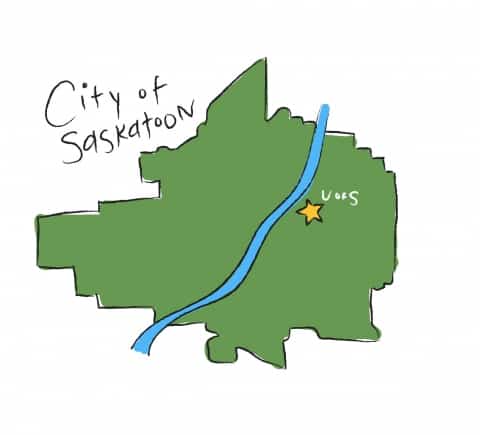Last month, the University of Saskatchewan and the City of Saskatoon agreed to a Memorandum of Understanding that will be a public commitment designed to formalize the already strong relationship between the two bodies.
U of S Students’ Union President David D’Eon discusses Mayor Charlie Clark’s enthusiasm for working with the university, which prompted the MOU.
“Charlie Clark has taken a proactive approach to working with the university; he has been meeting regularly with administrators and student leaders. The idea of the MOU arose to formalize the working relationship that has developed over the past year,” D’Eon said, in an email to the Sheaf.
The university draws in about 17,000 undergraduate students each year and also owns about 18 per cent of the land within a five-kilometre radius of the city centre. Because the U of S plays a significant part in making up Saskatoon’s community, the two organizations agreed to publicly commit to collaborating in a variety of key areas.

An agreement to go forward with the MOU, signed in September, was written by Jordan Sherbino, former USSU vice-president academic and current policy and communications advisor to Mayor Charlie Clark.
Although the official MOU has not been presented yet, D’Eon has been assured that the USSU will have a strong voice in drafting the final agreement.
“I will be there to ensure the MOU positively reflects a student perspective in the relationship,” D’Eon said. “It’s very difficult to say what will come of the agreement, as a draft hasn’t yet been presented, but what this could help us do is further develop and improve some of the services that the city already provides.”
The agreement will focus on four key areas: land development, infrastructure, strategic priorities and academic partnerships. Land development is being treated as one of the more pressing aspects of the agreement, as the university is planning infill developments for much of the agricultural-research area within the city.
Infrastructure will also be important, which has already been demonstrated by the city’s $4-million contribution towards the university’s new rink facility. A further area of interest to both parties is the tentative rapid-transit system, as U of S students represent a large portion of transit ridership. However, once the MOU is signed, students will not see the effects for some time, as both institutions will be developing plans for practical action over the coming year.
D’Eon explains that he hopes the MOU will develop more opportunities and resources for students and foster more partnerships, overall.
“What I would like to see come out of it is a dedication to student involvement, longer-term planning in areas of land development that benefit students and more efficient mechanisms for collaboration between the city and administration that can hopefully reduce barriers to further partnerships.”
—
Sydney Boulton
Graphic: Lesia Karalash / Graphics Editor